Continuing the First Draft
Mariah continued writing her essay, moving to the second and third body paragraphs. She had supporting details but no numbered subpoints in her outline, so she had to consult her prewriting notes for specific information to include.
Tip
If you decide to take a break between finishing your first body paragraph and starting the next one, do not start writing immediately when you return to your work. Put yourself back in context and in the mood by rereading what you have already written. This is what Mariah did. If she had stopped writing in the middle of writing the paragraph, she could have jotted down some quick notes to herself about what she would write next.
Preceding each body paragraph that Mariah wrote is the appropriate section of her sentence outline. Notice how she expanded roman numeral III from her outline into a first draft of the second body paragraph. As you read, ask yourself how closely she stayed on purpose and how well she paid attention to the needs of her audience.
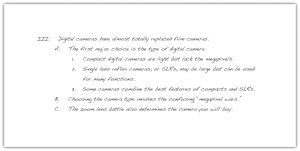
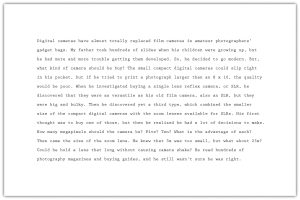
Mariah then began her third and final body paragraph using roman numeral IV from her outline.
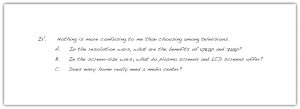
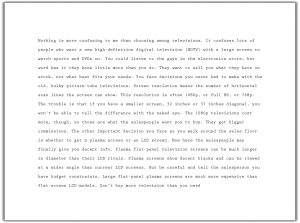
Exercise 3.3.4
Reread body paragraphs two and three of the essay that Mariah is writing. Then answer the questions on your own sheet of paper.
- In body paragraph two, Mariah decided to develop her paragraph as a nonfiction narrative. Do you agree with her decision? Explain. How else could she have chosen to develop the paragraph? Why is that better?
- Compare the writing styles of paragraphs two and three. What evidence do you have that Mariah was getting tired or running out of steam? What advice would you give her? Why?
- Choose one of these two body paragraphs. Write a version of your own that you think better fits Mariah’s audience and purpose.
Writing a Title
A writer’s best choice for a title is one that alludes to the main point of the entire essay. Like the headline in a newspaper or the big, bold title in a magazine, an essay’s title gives the audience a first peek at the content. If readers like the title, they are likely to keep reading.
Following her outline carefully, Mariah crafted each paragraph of her essay. Moving step by step in the writing process, Mariah finished the draft and even included a brief concluding paragraph. She then decided, as the final touch for her writing session, to add an engaging title.
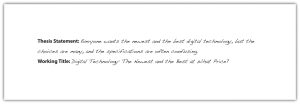
Writing Your Own First Draft
Now you may begin your own first draft, if you have not already done so. Follow the suggestions and the guidelines presented in this section.
Key Takeaways
- Make the writing process work for you. Use any and all of the strategies that help you move forward in the writing process.
- Always be aware of your purpose for writing and the needs of your audience. Cater to those needs in every sensible way.
- Remember to include all the key structural parts of an essay: a thesis statement that is part of your introductory paragraph, three or more body paragraphs as described in your outline, and a concluding paragraph. Then add an engaging title to draw in readers.
- Write paragraphs of an appropriate length for your writing assignment. Paragraphs in college-level writing can be a page long, as long as they cover the main topics in your outline.
- Use your topic outline or your sentence outline to guide the development of your paragraphs and the elaboration of your ideas. Each main idea, indicated by a roman numeral in your outline, becomes the topic of a new paragraph. Develop it with the supporting details and the subpoints of those details that you included in your outline.
- Generally speaking, write your introduction and conclusion last, after you have fleshed out the body paragraphs.

